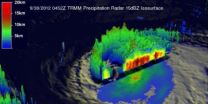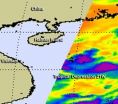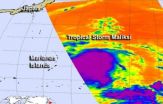New technologies advance livestock genomics for agricultural and biomedical uses
2012-10-02
(Press-News.org) MINNEAPOLIS / ST. PAUL (10/01/2012) —New genome editing technologies developed at the University of Minnesota for use on livestock will allow scientists to learn more about human diseases.
The genomic technique, known as TALENS, is described in a report published today in the scientific journal Proceedings of the National Academy of Sciences. The technique is cheaper and faster than previous technologies that allow scientists to genetically modify livestock animals; the animals are used to learn more about human diseases, which in turn can help researchers develop cures. U of M scientists and their collaborators used the technique to develop a swine model of cardiovascular disease in the diabetes-prone Ossabaw miniature pig.
The TALENS technique also can be used in agriculture, the paper notes, allowing livestock breeders to encourage or discourage a particular trait.
"Our efforts continue a long tradition of responsible animal breeding and research for the betterment of mankind," said Scott Fahrenkrug, an associate professor of animal science at the university and lead author of the PNAS paper.
Collaborators on the paper are from Texas A&M, the Roslin Institute at the University of Edinburgh and Recombinetics, a Twin Cities-based company created in 2009 to commercialize the techniques created at the University of Minnesota. The group's work and the TALENS technique also recently were highlighted in the journal Nature.
"This work embodies the effective translation of university research into meaningful applications that support Minnesota business," Fahrenkrug said. "We are proud to produce positive social and economic outcomes."
INFORMATION: END
ELSE PRESS RELEASES FROM THIS DATE:
2012-10-02
"Betcha can't eat just one!" For obese people trying to lose weight, the Lays potato chip advertising slogan hits a bit too close to home as it describes the daily battle to resist high calorie foods.
But new research by Terry Davidson, director of American University's Center for Behavioral Neuroscience, indicates that diets that lead to obesity—diets high in saturated fat and refined sugar—may cause changes to the brains of obese people that in turn may fuel overconsumption of those same foods and make weight loss more challenging.
"It is a vicious cycle that may ...
2012-10-02
NASA satellites continue to watch the long-lived Nadine in the eastern Atlantic. Today, Oct. 1, NASA satellite data revealed that Nadine has weakened from a hurricane and is now a tropical storm.
Over the weekend of Sept. 29 and 30, Hurricane Nadine dramatically rebounded. On September 19, 2012 Nadine appeared to be dissipating quickly and was expected to become post-tropical but after over a week of meandering near the Azores, Nadine sprang to life again as a hurricane on Friday September 28, 2012.
NASA's Tropical Rainfall Measuring Mission (TRMM) satellite's path ...
2012-10-02
The twenty-first tropical depression of the northwestern Pacific Ocean was born as a NASA satellite flew overhead on Oct. 1, capturing its "baby picture" in infrared light.
On Monday, Oct. 1 at 1500 UTC (11 a.m. EDT), Tropical Depression 21W (TD21W) had maximum sustained winds near 25 knots. It was centered about300 nautical miles south of Hong Kong, near 17.4 North latitude and 114.8 East longitude. TD21W has tracked northward at 5 knots and is expected to curve to the northwest and west.
On Oct. 1, 2012, infrared imagery from the Atmospheric Infrared Sounder (AIRS) ...
2012-10-02
The western North Pacific is in full swing, tropically speaking and NASA observed the birth of Tropical Storm Maliksi on Sept. 30. NASA's Aqua satellite captured an infrared image of the storm when it was a depression and revealed a large area of powerful thunderstorms around its center that hinted at its strengthening.
Tropical Storm Maliksi formed from the twentieth tropical depression of the western North Pacific typhoon season. Tropical Depression 20W formed on Sept. 20 about 305 nautical miles from Guam near 16.3 North and 149.0 East. It is moving to the north-northwest ...
2012-10-02
OAK BROOK, Ill. – New research from the Netherlands shows that the switch from screen film mammography (SFM) to digital mammography (DM) in large, population-based breast cancer screening programs improves the detection of life-threatening cancer without significantly increasing detection of clinically insignificant disease. Results of the study are published online in the journal Radiology.
DM's higher sensitivity at detecting breast cancer raised concerns that its introduction into screening programs would increase the diagnosis of clinically unimportant cancers—cancers ...
2012-10-02
OAK BROOK, Ill. – Water diffusion measurements with MRI could decrease false-positive breast cancer results and reduce preventable biopsies, according to a new study published online in the journal Radiology. Researchers said the technique also could improve patient management by differentiating high-risk lesions requiring additional workup from other non-malignant subtypes.
Dynamic contrast-enhanced MRI (DCE-MRI) has emerged in recent years as a useful tool in breast cancer detection and staging. One of its primary limitations is a substantial number of false-positive ...
2012-10-02
Washington — In an article published today (October 2, 2012) in the peer-reviewed journal Environmental Health Perspectives (EHP), People for the Ethical Treatment of Animals reports that the U.S. Environmental Protection Agency (EPA) High Production Volume (HPV) Chemicals Challenge Program had the potential to use 3.5 million animals in new testing, but after the application of animal-saving measures, approximately 127,000 were actually used. Although this toll in animal lives is high, it would have been many times worse had PETA not obtained major concessions from the ...
2012-10-02
Stroke care has improved considerably in Alberta following the implementation of the Alberta Provincial Stroke Strategy (APSS), leading to more targeted patient care and fewer health complications, according to a study presented today at the Canadian Stroke Congress.
Nearly 97 per cent of stroke patients received a brain-imaging scan during their admission to hospital in 2011, compared to 88 per cent before the APSS was implemented in 2006.
"The faster a patient has access to brain imaging, the faster they get the right diagnosis and the right treatment," says lead ...
2012-10-02
Improvements to the diagnosis and screening of sleep apnea are critical to stroke prevention, according to new stroke care guidelines released today at the Canadian Stroke Congress.
Obstructive sleep apnea, a disorder where the flow of air to the brain pauses or decreases during sleep, is both a risk factor for stroke and a complication following stroke, according to the Canadian Best Practice Recommendations for Stroke Care.
Among the general population sleep apnea increases the likelihood of having a stroke, even after controlling for other stroke risk factors, such ...
2012-10-02
A study of stroke patients from Southern Ontario found those who smoke have more difficulty with problem-solving and decision-making than non-smokers.
The study, presented today at the Canadian Stroke Congress, tested mental abilities of 76 patients, including 12 smokers, with an average age of 67.5 years, using the Montreal Cognitive Assessment (MoCA) tool. The MoCA exam tests patients with memory and problem solving questions and gives them a score out of 30.
Smokers had a median MoCA score two points lower than non-smokers -- 22 out of 30 compared to 24 out of 30. ...
LAST 30 PRESS RELEASES:
[Press-News.org] New technologies advance livestock genomics for agricultural and biomedical uses


